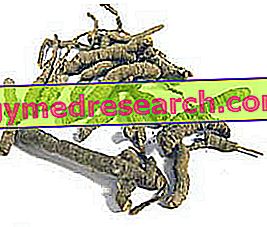What is Ipecacuana
Ipecacuana is a shrub native to India, also cultivated in South America and Malaysia. Belonging to the Rubiaceae family, it is distinguished commercially in two main varieties: Ipecacuana del Mato Grosso ( Cephaelis ipecacuanha ) and Ipecacuana maggiore or Costa Rica ( Cephaelis acuminata ).

Properties and Uses
Characteristic is the content of isoquinoline type alkaloids (1.8-4%), among which cephalin, psicotrin and emetine stand out. The latter substance, whose name refers to the term emesis, underlines the main phytotherapic application of Ipecacuana, which is precisely that of inducing vomiting. This effect is due in large part to the irritating action on the gastric mucosa and to a lesser extent to the direct stimulus on the vomiting center.
Also registered as a medicinal product, Ipecacuana syrup is used to reduce the absorption of ingested toxic substances; this action is obviously greater the faster it is administered after the ingestion of the toxic substance. At lower doses, the effect of these alkaloids makes them of potential use as fluidifying bronchial secretions, given their demonstrated ability to increase the amount of mucus and its fluidity, while exerting a spasmolytic effect at the bronchial level. In this sense the indications of the Ipecacuana range from pertussis, to spasmodic coughs and to various forms of bronchitis.
Ipecacuana extracts, and in particular emethin, have also proved effective in eradicating the infestation of Entamoeba histolytica, a parasite that causes violent dysentery attacks. In small doses, Ipecacuana tincture has a stimulating effect on gastric secretion, appetite and digestive processes. Finally, in homeopathy, there are uses in the case of spasmodische coughs, bronchitis, asthma, or due to indigestion accompanied by nausea, diaree and hemorrhagic rectocolitis.
Side effects and contraindications
While preserving a certain phytotherapeutic use in developing countries, in the more industrialized nations the herbal use of Ipecacuana is now limited, due to the frequent side effects (nausea, gastrointestinal irritation); the drug instead maintains a certain use as an emetic drug in emergency therapy.
The effect of emetic medicines based on Ipecacuana syrup is manifested within 15-30 minutes of ingestion, and is particularly useful in case of toxic poisoning. In such circumstances any emetic active principle is however contraindicated in front of the ingestion of corrosive products, which could be dangerous if aspirated.
The medicine should not be administered after ingestion of strong acids, alkalis, strychnine, distilled oil or corrosive substances. Its use is also contraindicated in semi-conscious or unconscious persons (to avoid the passage of the vomited material in the airways).
The illustrative leaflet also states that Ipecacuana syrup is contraindicated for patients with cardiovascular disorders; the important systemic absorption of emetin, often resulting from the drug's failure to induce vomiting, may in fact give rise to cardiac side effects, such as conduction abnormalities or myocardial infarction. The doses of ipecacuana are generally followed by copious fluid intake to avoid vomiting-induced dehydration.



